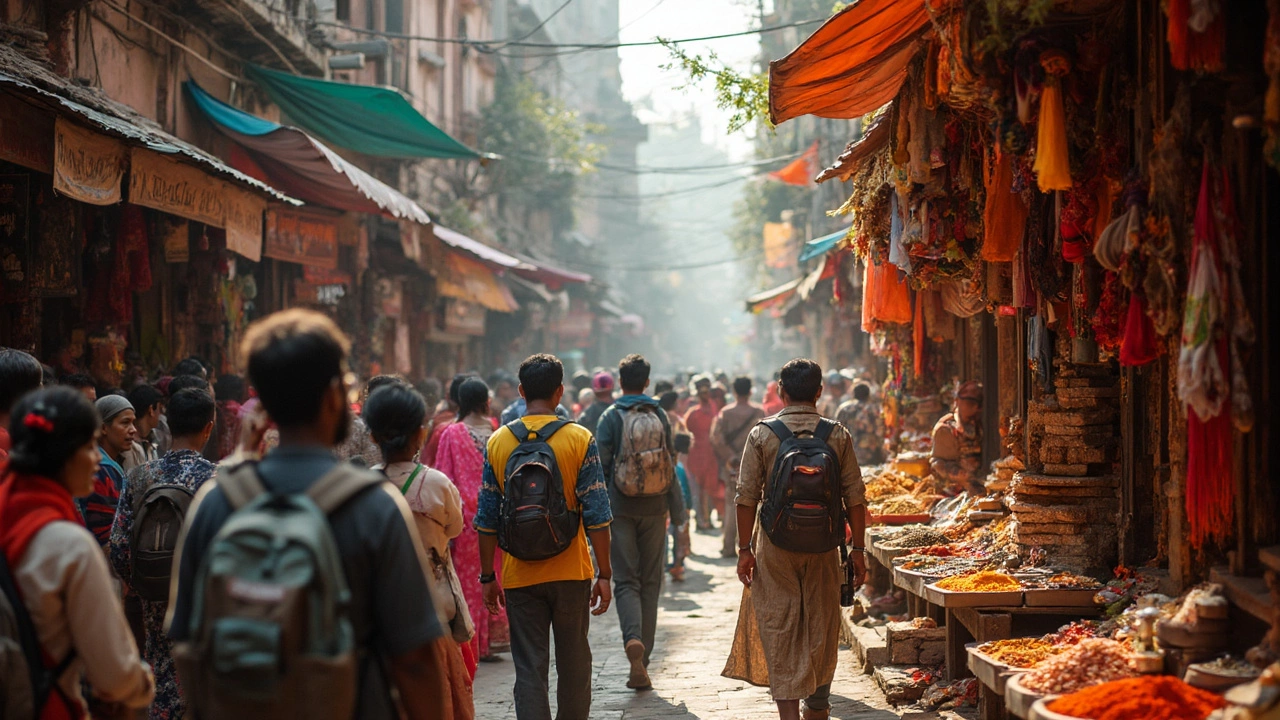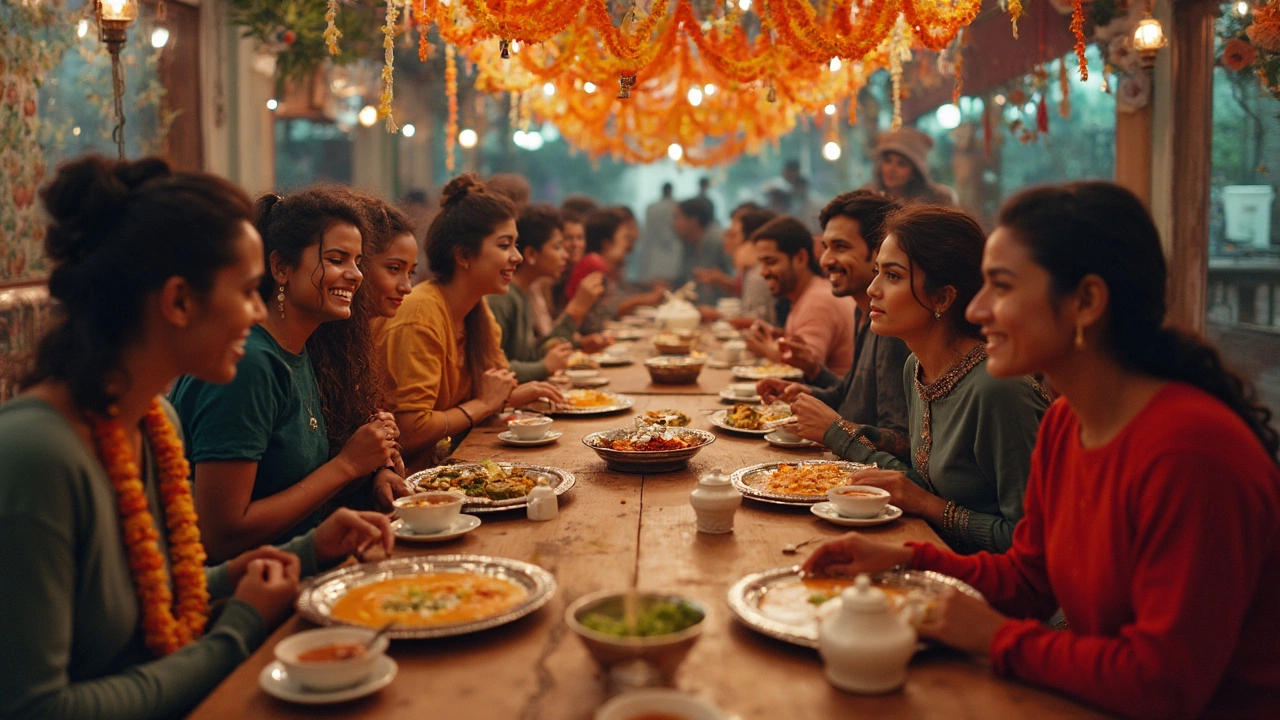Is India an Expensive Country to Visit? Budget Travel Tips and Insights
 Apr, 22 2025
Apr, 22 2025
India likes to surprise people when it comes to travel costs. Some travelers come expecting backpacker prices everywhere, while others think they’ll find five-star bills around every corner. The wild part? You can blow through your savings in luxury hotels, or comfortably live on $20 per day if you play it smart.
Your daily expenses depend massively on where you go and how you like to travel. For most travelers sticking to local guesthouses, eating everyday meals, and using trains or rickshaws, India is usually cheaper than places like Thailand or Brazil. But if you’re aiming for air-conditioned cabs, international food, and hotel chains, you’ll feel the burn on your bank account much faster.
Knowing the landscape is key. Street food stalls sell hearty vegetarian dishes for less than the price of a coffee back home, yet beach resorts in Goa might charge big-city prices. Trains are famously affordable, but a quick Google search shows some overnight tickets on India’s best lines can cost almost as much as a flight. If you plan ahead and adjust to how locals get around and eat, you’ll see just how far your travel budget can go—and where you might want to splurge a little for comfort and safety.
- Daily Costs: What You Really Spend
- Saving Big on Accommodation, Food & Rides
- Hidden Costs and Tourist Traps
- Smart Strategies for Budget Travelers
Daily Costs: What You Really Spend
If you’re wondering what you’ll actually spend day-to-day in India, it all comes down to choices. India travel costs can swing wildly depending on your style. Backpackers often get by on a shoestring daily budget, while others rack up much higher bills chasing comfort and convenience.
To give you real numbers, here’s a breakdown of average daily expenses for anyone thinking about budget India travel. These are typical prices as of early 2025 from major cities and tourist spots:
| Item | Budget Range (USD) |
|---|---|
| Bed in hostel dorm | $4 - $12 |
| Basic guesthouse room (private) | $8 - $22 |
| Street food meal | $0.50 - $2 |
| Simple restaurant meal | $2 - $6 |
| Local bus/Metro ride | $0.15 - $0.80 |
| Rickshaw ride (short) | $1 - $3 |
| Train ticket (3rd class, short trip) | $1 - $3 |
| SIM card with data (monthly) | $3 - $5 |
| Entry to major attraction | $3 - $12 |
If you stick to budget stays, local eats, and use public transport, a regular day’s spend sits around $15–$25. If you go for AC rooms, international food, or use Ubers everywhere, you could easily spend $40–$60 a day. Tourist hotspots like Mumbai, Delhi, or beach towns like Goa usually cost more; small cities and rural areas are way cheaper.
Cash is still king, so keep small bills handy. Many places don’t take cards, especially at markets or food stalls. To get the most from your backpacking India adventure, download a fare-splitting app for rides, eat at thali joints (buffet-style plates), and book train tickets in advance when possible—last-minute can triple the price.
Bottom line: Cheap travel India is totally doable, but it’s easy to overspend if you’re not paying attention. Always keep wiggle room in your budget for random temple fees, extra water, or impulse street snacks. A little flexibility makes your experience way less stressful—and way more fun.
Saving Big on Accommodation, Food & Rides
If you’re traveling India on a tight budget, where you sleep, eat, and how you get around can make or break your trip. The good news? India is basically built for budget travelers. If you know what to look for, you’ll find deals almost everywhere.
Hostels are everywhere in major cities and most tourist hotspots. Unlike the expensive ones you might find in Europe, plenty in India offer dorm beds for under $8 a night, with free Wi-Fi and sometimes even breakfast. Chains like Zostel and goStops have popped up in dozens of cities—not just Delhi, Mumbai, and Goa. Guesthouses are just as common and often cheaper, especially if you book on the spot instead of online.
When it comes to eating out, skip the tourist restaurants. They charge way more for basically the same food. Eating where the locals eat gives you real flavors—for as little as $1 a plate. Try a thali (a big tray with rice, dal, veggies, and bread) at a neighborhood spot or grab dosas and samosas from street vendors. If you stick with vegetarian food (which is everywhere), you’ll spend even less.
Transport is another area where you can make or lose a lot of money. Indian trains, especially in sleeper or second-class, are legendary for budget travelers. A train ride from Delhi to Agra in non-AC class can cost you less than $2. Buses are almost as cheap and connect even the smallest towns, though comfort can be hit or miss. For short distances, rickshaws are best, but always agree on a price before getting in—or insist on the meter. Ride-hailing apps like Ola and Uber are now available in most cities and sometimes work out cheaper than haggling, plus you can track your route for safety.
Here’s an idea of what basic daily travel can cost if you stick to budget options (as of 2025):
| Expense | Budget Option | Typical Cost (USD) |
|---|---|---|
| Accommodation (budget India travel) | Hostel, Guesthouse | $5 - $10 |
| Food (cheap travel India) | Local restaurants, street food | $2 - $6 |
| Transport (India travel costs) | Bus, non-AC train, rickshaw | $1 - $4 |
At this pace, you can easily see India on less than $20 a day if you’re careful. Of course, your costs go up if you want private rooms, AC taxis, or Western food, but it’s good to know you can travel super cheap and still get a real taste of India.

Hidden Costs and Tourist Traps
So you’re watching your wallet, eating local, and budgeting those overnight trains—then suddenly, bam, you’re hit with a random ‘service charge’ or roped into an overpriced sightseeing trip. Even though India travel costs can be super low if you plan right, it’s easy to get caught off guard by sneaky expenses that don’t show up in the guidebooks.
The first thing to watch for: entrance fees. Major monuments like the Taj Mahal charge foreigners a lot more than locals. You’ll see a regular ticket for locals at around ₹50 (less than $1), and a “foreign tourist” ticket at ₹1100 (about $13). It adds up fast if you’re hitting several big spots.
Taxis and rickshaws are another place where you might pay double, especially if you’re fresh off the train or at the airport. Drivers often refuse to use the meter, tossing out a “fixed price” that’s conveniently triple the real rate. Always ask around first, or use ride-hailing apps when you can.
Guided tours and ‘package deals’ often sold in touristy areas can also drain your wallet. Many sound like bargains but include shops where you’re pressured to buy souvenirs at inflated prices. If it’s a friend-of-a-friend arrangement or anyone pushes you too hard, walk away.
- Backpacking India: Don’t pay cash upfront for rooms you haven’t seen. Some budget hotels look way better online than in real life.
- Even with cheap travel India, always double-check restaurant bills—sometimes there are bogus add-ons or ‘luxury taxes’ you didn’t expect.
- Keep small notes handy; some vendors will ‘not have change,’ making you overpay by default.
Honest tip: slot in an extra 15-20% on top of what you think you’ll need each day, just for all the little surprises. It’s way less stressful to be prepared for a couple rupee hiccups instead of watching your daily budget spiral at the last minute.
| Common Tourist Trap | Extra Cost (in Rupees) |
|---|---|
| Taj Mahal entry fee (foreigner) | 1100 |
| Airport taxi (unmetered) | +300-700 over metered rate |
| Monument camera/video fee | 200-500 |
| 'Special' tour guide | 500-2000 per day |
Being aware of these tricks means you’ll breeze past most of the traps—and your budget India travel dreams will actually work out.
Smart Strategies for Budget Travelers
Pulling off a budget India travel adventure is totally possible, but it means being a little street-smart. Let’s get real about how to keep your costs low while still getting the best out of what India offers.
- Stay Where Locals Stay: Skip the international hotel chains. Guesthouses, homestays, and hostels in India can go for as little as $5–$15 per night, especially outside major tourist hotspots. Look for places with decent reviews on sites like Hostelworld or Booking.com—don’t just grab the first deal because it’s cheap.
- Eat Like a Local: Indian street food and small local restaurants (called dhabas) are cheap and delicious. For $1–$3, you can fill up on a proper meal, especially in North India. If you go for Western chain restaurants or trendy cafes, you’ll sometimes pay more than you do back home.
- Choose Public Transport: Taking public trains and buses slashes your costs. Intercity trains, sleeper buses, and metro rides in cities like Delhi and Mumbai are reliable and affordable. Don’t ignore rickshaws—just agree on the price before getting in, or insist on the meter.
- Travel Off-Season: Avoid main holidays and peak tourist months (December–February). Room prices drop by up to half in the shoulder seasons, and you’ll face smaller crowds.
- Haggle (When Appropriate): Bargaining isn’t rude in local markets. Vendors expect it, so don’t pay the first price for souvenirs, rickshaw rides, or sometimes even rooms.
- Use Local Apps: Apps like Zomato (for food), Ola/Uber (for cabs), and RedBus (for bus tickets) will save you both money and headaches by showing real prices and avoiding tourist traps.
To give you a feel for how stretched your budget can be, here’s a quick breakdown of typical daily costs when backpacking across India. This is for a solo traveler who’s comfortable with no-frills options and sticks to local living:
| Expense | Low Budget (INR) | Low Budget (USD) |
|---|---|---|
| Bed in Hostel/Dorm | 400–700 | 5–9 |
| Basic Meal | 80–200 | 1–2.5 |
| Local Transport (daily) | 100–250 | 1.2–3 |
| Entry Fees (1–2 sites/day) | 200–500 | 2.5–6 |
| Daily Total | 800–1650 | 10–20 |
One more thing: keep digital and physical copies of your ID handy. Many budget hotels and train stations ask for it, and you don’t want to get caught scrambling at a busy counter.
By mixing these smart moves, you’ll really stretch your money while still experiencing the best sights, food, and culture India offers. Backpacking India and traveling cheap doesn’t mean missing out—it usually means you get way more real experiences for less cash.